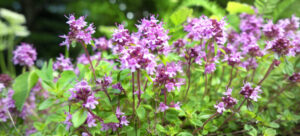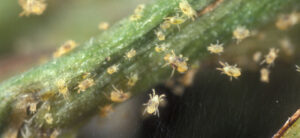
As summer rolls around, one of the many things you may be tasked with as an outdoor grower is how to get rid of June bugs on your plants.
These are just one of the many common garden pests that can plague growers, and these insects in particular don’t get discussed enough. There are far more aggravating, common pests like aphids, mealybugs, scale insects, etc.
However, June bugs, as members of the scarab family, can actually be quite detrimental in a garden. June bugs can not only feast on your favorite trees and shrubs, but they can leave behind ragged holes and plenty of damage in their wake, too.
Fortunately, eliminating these pests in your garden is often as simple as enacting a few basic methods of prevention. Should you end up with an infestation on your hands, though, we have some tips on how to get rid of June bugs on plants fast.
Let’s start by discussing what these bugs are, and how to identify them and signs of their damage.
What Are June Bugs?

June bugs are large, inch-long beetles that are part of the scarab family. In fact, there are several different bugs in this family for you to be aware of, including the green June beetle, the equally pesky and iridescent Japanese beetle, the brown chafer beetle, and the ten-lined June beetle.
All of these pests can be found in North America, where they inflict damage on all kinds of plants (but most notably, roses, trees, and various shrubs).
They are most common in very warm areas, so while you’ll find June bugs if you’re living in a northern state, you’re more likely to have to deal with them on a larger scale if you live in the south.
These oblong beetles have hard brown wings and stomachs that are green or yellow. Although they don’t bite and will mostly leave humans alone, the same cannot be said for your plants.
What Harm Can June Bugs Do To Plants?

Adult beetles will inflict plenty of destruction on their own, but the real villain to watch out for is the June bug grub.
June bug grubs live in the soil and feed on the roots of plants, particularly grass. If you have a June bug grub problem on your lawn, you’ll likely notice signs and symptoms like patches of brown, dead lawn that can be pulled from the soil in chunks.
But do June bugs kill plants? Sadly, they can - but the good news is that they’re sometimes easier to stop in their tracks than other kinds of pests.
June bugs, despite their name, are actually active all summer (but they are most active during the late summer, which is when the grubs are most active underground).
You’ll know it’s June bugs that you’re dealing with when you see the tiny, curled-up grubs underneath the soil in your garden.

It’s not just grass that June bugs can decimate. These pests are also notorious for going after the roots of other plants, including carrots, potatoes, and other root crops. These voracious feeders will also go after other plants and flowers (including vegetable seedlings) in the yard, too.
Fortunately, adult June bugs aren’t as damaging, and while they’ll feed on the leaves of trees like walnut and oak (along with their bark, occasionally, too) the grubs are the real enemy to be aware of.
Do be aware that June bugs can also attract other kinds of garden pests, too. There are all kinds of creatures that feed on June bugs, including box turtles, skunks, toads, moles, and gophers.
How Do I Keep June Bugs Off My Plants?

Eliminating a June bug problem is much easier if you actively work to prevent it in the first place. This is pretty much the case with any pest. There are several steps you can take to keep June bugs off your plants.
First, consider whether you can attract beneficial predators to your lawn. Some natural predators include toads, birds, and snakes, most of which will not pose any threat to your garden plants. To attract them, consider putting out a shallow dish of water for toads and snakes or a birdbath for your avian friends.
You should also consider changing up the way you care for your lawn and garden plants. For example, avoid mowing too low. Mowing your lawn too short can encourage female June bugs to lay their eggs, as they prefer short grass. Keep it to at least three inches tall, particularly during the early to mid-summer season.
How To Get Rid Of June Bugs In The Garden
Now, even the best june bug prevention methods fall short from time to time. If you live in a climate conducive to these insects, you may find yourself fighting them year after year.
We’ll share some tips to help you get rid of june bugs on your plants quickly and safely.
Manually Remove June Bugs From Plants

Going on a June bug hunting spree might not necessarily be your idea of a good time, but the truth is that it can be an effective way to get rid of the pests in your garden.
They move slowly, so it won’t take a lot of effort. Simply pull them off shrubs and other plants when you happen to find them and drop them into a jar of soapy water. They’ll drown instantly.
Don’t want to sit around and wait to catch June bugs by hand? You can also set up a trap overnight. To do this, combine half a cup of molasses with half a cup of hot water in a large jar.
Cover the jar, shake it well, then put the open jar near the plants that are being damaged by the June bugs. Check the trap each morning and get rid of any drowned beetles, refilling the mixture as necessary.
Not only is this method very effective in terms of getting rid of June bugs on plants, it allows you to restore balance to your garden without using any chemicals or harming your plants.
Bring Nematodes To The Fight
Nematodes are tiny, microscopic worms that can be incredibly helpful in attacking and eliminating grub problems of all kinds - including June bugs.
You can purchase nematodes online and introduce them to your lawn. The worms will do the rest, preying on the June bug grubs for you.
How To Get Rid Of June Bugs With Pesticides

Using an insecticide, particularly a commercial or synthetic insecticide, should not be your first line of defense. However, when all else fails, these treatments are helpful in getting rid of June bugs in the garden.
You don’t have to instantly spring for a synthetic insecticide, either. There are several natural insecticides, like neem oil, that will kill many types of larvae (including June bug grubs) without harming beneficial insects like bees. These are best applied late in the summer, when the grubs are near the top of the soil.
You can even make your own natural insecticide, although this might not be as fast-acting or effective, depending on the scale of your infestation. You can make a natural insecticide by combining a few cloves of minced garlic with a tablespoon of mineral oil.
Let the solution sit overnight, then strain out the garlic and add the mixture toa pint of water. Add a teaspoon of dish soap, then apply the spray directly to your plants. It should do the trick on June bugs as well as all kinds of other common garden pests, like aphids.
Use An Insecticide (Preferably With Bacillus Thuringiensis)
Also known simply as Bt, Bacillus thuringiensis is a kind of bacteria that infects and kills all kinds of garden pests, including June bugs.
Fortunately, it’s harmless to humans, pets, and beneficial insects. You can apply it as a spray, powder, or liquid concentrate directly to your plants. It may need to be reapplied on a weekly basis to be truly effective.
If you are going to take the pesticide route, we recommend finding one with BT as an active ingredient. One of the best options is Blacksmith BioScience Armory Beneficial Bacillus.
Final Thoughts On How To Get Rid Of June Bugs
Unfortunately, getting rid of June bugs is easier said than done. You may find that, when you’re dealing with June bugs, your focus needs to be to control a population rather than eradicate it entirely.
The good news is that here at Hydrobuilder we have everything you need to get rid of June bugs on your plants - and fast. From neem oil and insect traps to systemic insecticides and OMRI-listed pesticides, we have a whole host of solutions you can choose from to help get your June bug problem under control.
With a bit of planning and vigilance, your awful experiences with June bugs should rapidly become a thing of the past.
































